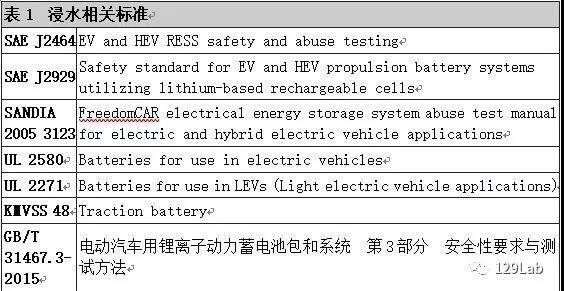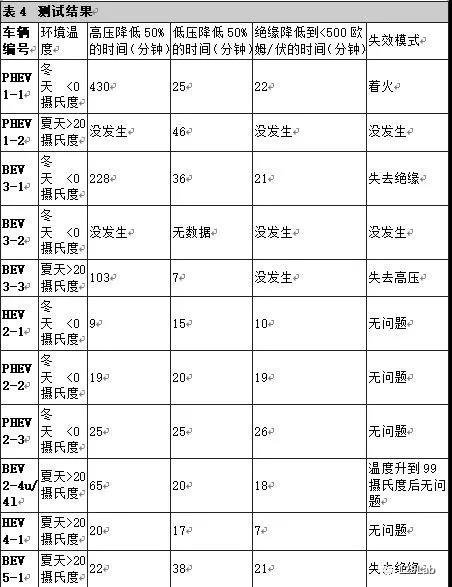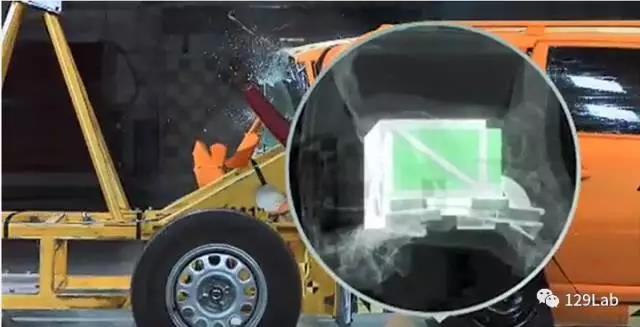Electric vehicle immersion experiment, collision and battery safety
Vehicles need rigorous environmental testing to verify whether the vehicle and its components can withstand various misuses. Some of the tests are mandatory and some are recommended. For example, the FMVSS standard of NHTSA of the national highway traffic safety administration of the United States is mandatory. In terms of security of electric vehicles, vehicle water (or water) for the vehicle itself and its parts, especially the high security is not a small test. In view of the safety requirements of water immersion, there are some international standards for reference (Table 1). These standards are mainly used to assess the battery pack.

TUV SUD has conducted a study on electric vehicle immersion test conditions set in, in reference to some of the requirements of the standard testing process, besides voltage monitoring high-voltage battery pack, battery voltage 12V is monitoring, test conditions and specific parameters set in table 2.

The selection of test vehicle is shown in Table 3, which mainly considers the old and new state of vehicles, or w hether they have done collision tests, the temperature environment of vehicles, the types of vehicles, etc.

In the 2 hours of water soaked in water, some vehicles showed some unexpected phenomena. For example, the car lights, wipers and loudspeakers will be accidentally opened. This may be due to the electrical conductivity of the brine solution, which causes the electrical switches inside the vehicle to be closed.
During the 28 day observation period, one PHEV was on fire, and the temperature of a BEV battery pack rose. The PHEV fire lasted 7 hours and the vehicle was completely burned. The test staff initially estimated that the battery pack was out of control. However, the root cause of the fever was out of control due to the complete burn up of the battery pack. In addition some test vehicles have also been some other interesting phenomena: the high voltage relay itself closed for 6 minutes; 25 minutes after the high voltage insulation resistance decreased to 0 ohm; by monitoring the temperature reached 850 degrees Celsius in the fire; fire PHEV battery pack inside the burning, but the external battery box intact that is just burned black, etc.. Table 4 summarizes some of the test results

In the test vehicle, the battery covers the whole sealed and unsealed two types of battery pack, the test results showed that: all the high voltage and observed within 1 hours of the insulation drop of the battery pack is used in the non fully sealed design, but the insulation resistance decreased in varying degrees, although some decline the single is not the risk of electric shock. The sealed design of the battery package can prevent the internal high pressure components and their circuits from being intruded by a conductive saline solution during the immersion process. In addition, the phenomenon of voltage drop during the immersion process of 12V battery can prevent the accidental pull of high voltage relay to a certain extent, because high-voltage relay is usually powered by low voltage circuit.
From the above test phenomenon, in the response to the immersion situation of electric vehicles, the design of battery structure with high sealing appears to be a good choice. For 12V batteries on low voltage circuits, it is hoped that it can discharge and step-down as soon as possible when immersed in water. Due to the different distribution of battery packs on the vehicle, in the specific development process, we need to consider the factors of installation location, water depth, environmental temperature, sealing and electrical insulation.
Abroad in the development process of electric vehicle, but also set up the mechanism of high security problems of electric vehicles when a fault occurs, the firms will set up first responder (first dispatched personnel, dangerous goods accident when they first arrived at the scene of the personnel) high voltage safety processing, ensure that first responder can effectively protect their own safety in the implementation of the rescue, troubleshooting, to prevent electric shock. Recently the standard group also organized to prepare the relevant guidelines, rescue the safety of vehicle accident requires similar, this requirement also more with OEMs and rescue organizations to communicate effectively, so as to ensure the rescue guidelines formulated with reliable operation.
Volvo has done a full - Car Rear - touch experiment, and the battery is in the trunk (below).

The battery is not installed in the trunk and the occurrence of serious deformation by vertical collision as expected, but with the battery mounting body structure connection part of the serious deformation of the battery arch up (below),


This reduces the battery by the extrusion pressure to a certain extent, so that the battery in the collision process and has not been shown similar serious extrusion deformation, the reasonable design of the body structure can be reduced to some extent. By the risk of collision between the battery.
Considering that during the 7.6 section extrusion test of GB/T 31467.3-2015, there is a lot of controversy about the extrusion pressure requirement of 200kN. Many enterprises reflect that the extrusion pressure is too large, which is not consistent with the actual vehicle design. The implementation of a period of time in the standard, GB/T has released the first 31467.3-2015 modify list, accept the feedback standard organization of enterprises, considering the body structure for the protective effect of the battery, will lower the requirements of 200kN to 100kN, this also with the current international ECE R100 and ISO12405-3 requirements remain the same.
In vehicle crash test, the classic test regulation requirement for battery collision safety is FMVSS 305 (Federal Motor Vehicle Safety Standard No.305), which is required for collision test.
The energy storage system is not intruded in the passenger compartment and can be kept in its original position.
The insulation level of the energy storage system is not less than 500 ohm / volt
The leaked electrolyte does not enter the passenger compartment, and the electrolyte leaked out of the passenger compartment can not exceed 5L
Because the power battery itself is equipped with energy, in addition to the safety preparations for traditional car collision, IIHS recommends other safety issues for electric vehicles, such as:
Position of manual maintenance switch
The installation position of the energy storage system and the high voltage wire harness
Detecting the connection position of the insulation resistance test circuit of the energy storage system
Charging and discharging methods of energy storage system
Chemical properties of battery coolant
The MSDS of the battery and its components
Special hazard information for testing the energy storage system of electric vehicles
In 1992, IIHS opened the Vehicle Research Center (VRC). By evaluating the crashworthiness of vehicles, it helps consumers choose safer cars, and helps manufacturers improve vehicle safety design. Beginning in 2004, the US IIHS and Australia ANCAP (Australasian New Car Assessment Program) launched a collision avoidance test (crashworthiness test) for hybrid electric vehicles and electric vehicles.
25% overlap ratio positive bias collision Small overlap frontal, speed 64km/h
40% overlap ratio positive bias collision Moderate overlap frontal, speed 64km/h (Figure 2)
Side impact Side, speed 50km/h
The strength of the top of the car Roof strength
These test items are basically similar to the gasoline vehicle crash test, but the EV test is more concerned about the hazards of HV electrical system, especially the potential hazards of HV batteries after collision: high voltage leakage, battery electrolyte leakage and ignition. According to the extent of battery damage and the speed of chemical reaction inside the battery, the hazards caused by batteries can sometimes be directly shown, sometimes they can not be directly displayed. This also brings certain challenges to deal with such collision vehicles. Here we review several classic cases of ignition of electric vehicles, showing three different battery failure models.
In 2011, General Motors' Volt electric vehicle carried out a 18 mph side impact test at MGA Research in Wisconsin. Three weeks later, Volt's lithium ion battery began to fire and the fire spread rapidly to three adjacent cars. Accident investigation found that after that, a small amount of battery coolant penetrated into the battery box after the crash test, resulting in short circuit inside the battery, and finally developed into the thermal runaway of the battery.
In 2012, the United States of New Jersey hurricane Sandy caused a port 16 Fisker Karma electric car, fire water. After the accident analysis shows that the water caused by the lithium ion battery Karma electric cars to the thermal runaway and the fire, the fire spread ignited nearby 15 electric cars (the case with little correlation collision because the results did not mention whether the hurricane caused the collision of the vehicle and other external mechanical shock).
In 2013, two Tesla Model S caught fire: the first car hit the ground metal while driving on Washington D.C., and the second car hit the trailer trailer hook on the road in Tennessee. The two accidents were due to the debris or debris on the road that pierced the chassis and battery pack at the high speed of the car, causing battery failure and heat loss. Tesla later installed a protective panel on the chassis to protect the battery. In 2014, a stolen car thief was disintegrated into two halves after driving a stolen Tesla electric car. The battery pack was thrown out of the car and caught fire.
A few cases (except second with no direct evidence related to the collision) are anti-collision safety on the performance of the cell challenge, forcing the battery manufacturer or the vehicle manufacturer in the battery product design verification stage we need to consider all possible collision safety problems, from setting the corresponding solutions. With the progress of technology and the accumulation of experience, there have been many standards and regulations to regulate the security of these batteries. For example, SAE J2464, J2929, J2380, ECER100. Our country has also made the corresponding national standard, for example, GB/T 18384-2015, 31467.3-2015, 31498-2015. These standards and regulations introduced all kinds of test methods for simulation of mechanical and electrical hazards cell system under different environments may encounter, and in each of the tests, standards and regulations usually require battery leakage, rupture, fire and explosion, some project requirements of insulation resistance should be greater than 100 ohm / V or more.